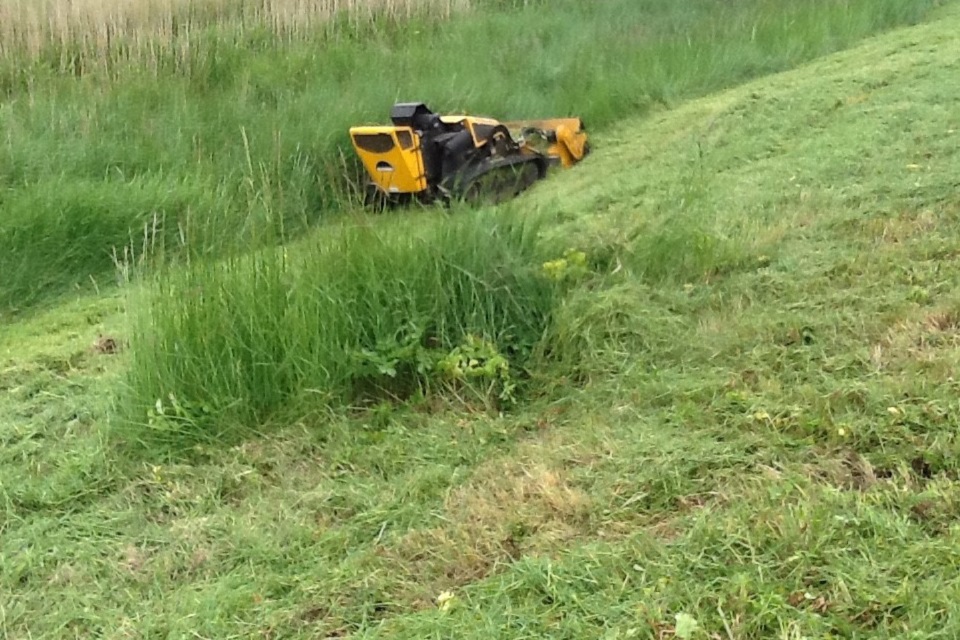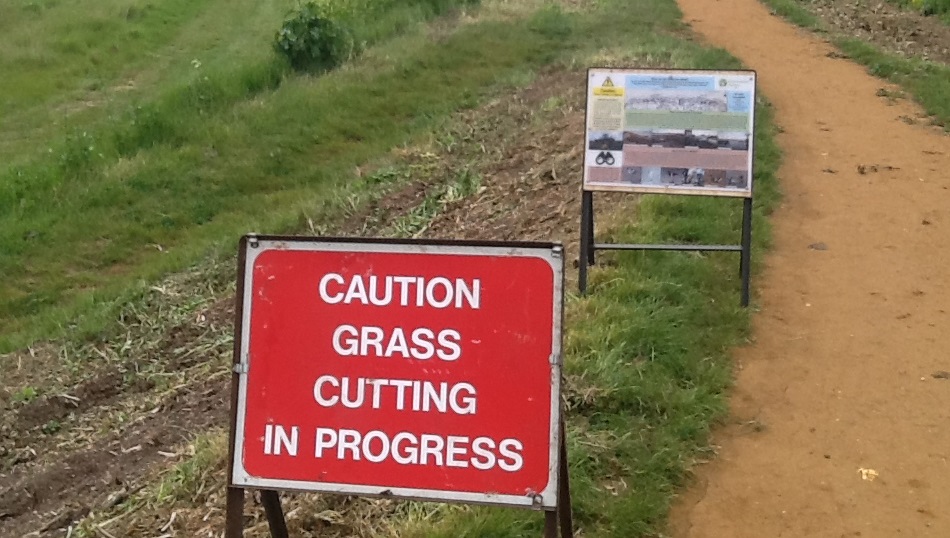My name’s Martin Howarth, I manage the Asset Performance Team in Norfolk. The team’s role is to ensure our flood defences are well maintained and able to cope with the pounding they regularly receive from the powerful North Sea waves.
Much of the North Norfolk coastline is protected by flood banks made of earth and clay. These banks perform a vital role in protecting people, properties and designated sites, such as nature reserves, along the coastline. Given that they’re made of natural materials, they’re able to blend into their surroundings and become features in their own right.
However, without regular maintenance, the flood banks can soon lose their effectiveness. Left to nature, the defences get covered in thick, tall vegetation with woody stems. The tall vegetation crowds out the light leaving bare earth underneath. As a result the banks become vulnerable to wave damage during tidal surges, such as the ones experienced on the east coast in 1953 and 2013. This can happen to natural defences all along the east coast.
It might seem counter-intuitive but, during a surge, tall woody vegetation easily gets ripped out by wave action leaving holes and causing weakness in the bank that may cause failure. Additionally their deeper and stronger roots adversely impact the integrity of our flood defences. Through our maintenance we try to encourage shorter lower growing native grasses and wildflowers that better protect the banks.
We know that the sight of our mowers cutting lush vegetation can be distressing to some people, particularly bird lovers, but our approach is very considered. My team liaise with our biodiversity specialists who, in turn, liaise with organisations like Natural England to obtain the necessary permissions needed to do undertake work in designated sites. When the work is taking place, our operations staff have a good look at the section they’re cutting before they start to make sure there are no bird nests in the path of the mower. If we believe there are nests present we give them a wide berth.

As for the mowers, they’re not your average garden mower, the low hum from the engine is designed to minimise disturbance making them less likely to startle birds. We also set the height of the blades at a level that ensures any small creatures present are not harmed. Where possible, someone walks in front of the mower to spot nests or anything else living that may be present.
In most years we don’t cut between April until the end of July but, in the years following the 2013 surge, there’s been a need to do an additional cut to try and better control the undesirable vegetation. This is certainly the case with invasive species such as Alexanders from Southern Europe and Black Mustard from North Africa. These plants grow prolifically and leave exposed vulnerable banks underneath. By managing these nuisance species we hope we can encourage dense native grasses to cover the defences that will be more resilient in surge conditions and attract a wider range of wildlife too.
I hope this gives you an insight into the method behind what looks like madness. Our operations staff will always try and put up a sign detailing what work is being carried out but, if you don’t see a sign, or you want to know more, feel free to ask one of our operatives on site or call us on 03708 506 506 and we’ll do our best to explain.
Getting the balance right between protecting people, property, wildlife and the environment can be difficult but, please be assured, whether its grass cutting or major construction projects, we always consider the impacts of our work.


13 comments
Comment by Dr Mick Phythian posted on
Nothing on there about removing the arisings? Suggest reading Chapter 9 of Floodplain Meadows - Beauty and Utility, A Technical Handbook as referred to in next blog. Flood defences can contribute to the role of flood meadows in biodiversity.
Comment by Helen Beardsley, Environment Agency biodiversity officer posted on
The Floodplain Meadows handbook is an excellent document that we refer to a great deal.
Removing the arisings has in recent years become more of an issue due to the type of tall, woody, growth present. This is something we are looking to do during future maintenance operations.
Comment by Bob Crook posted on
As someone who has worked in nature conservation management for 30 years, including wetlands and coastal, and for Natural England; Broads Authority; and RSPB i have to say your article sounds completely absurd ! Another case of a government agency with too much money to waste and doing its own thing! So much for the EU Habitats; Birds and Species Directives ( not to mention Biodiversity Action Plans ) ! You are a disgrace to our natural heritage.
Comment by Kevin Jackson posted on
Why have the flood banks to the River Soar in Sutton Bonington not had their grass cut this year?
Comment by kathrynbooth posted on
After speaking with the local team, we can confirm that they cut the grass on the River Soar in Sutton Bonnington on 7th June 2017. Our field operatives are undertaking another grass cut today, 18 July, and are likely to cut this stretch of the bank again in approximately 6 weeks
Comment by Christine Oates posted on
Regarding the river Ouse bank defences at Swinefleet and Old Goole, when your guys mow the wide roadside riverbanks as they are doing today, it is revealing lots of plastic bottles and the usual disgraceful litter. Today your guys (3 of them ) were watching a radio controlled mower do this. Why can't they pick up the litter instead of watching this machine. You go by the name of Environmental Agency yet you seem to be oblivious to this environmental bio-hazard which no doubt lots of it will end up in the river!
Comment by Adam Bayliss posted on
Hi Christine,
Im an Asset Performance Team Leader in Yorkshire, sorry this hasnt been picked up yet ive just stumbled across this thread. Thanks for your observation, our internal team and suppliers should be picking up any plastic debris before undertaking any maintenance of this type. Ive fed back your observation to the team that complete that section of maintenance so it can be addressed, if you see similar you can report it to us any time on 0800 80 70 60.
Thanks,
Adam
Comment by DavidJax posted on
Good site!
Comment by Ian wellesz posted on
The usual EA nonsense, pretending they care about biodiversity. It's just boys having fun with tractors . They'd mow all the nature reserves if they could get away with it.
Comment by David Wheldrake posted on
Any chance of cutting the riverbank at Skelton, East Yorkshire?
The opposite bank at Hook is like a lawn, whereas the Northbank of the Ouse is like a jungle. This is obscuring the vision on the adjacent road and will cause an accident. The Riverbank at Skelton also is part of the "Trans Pennine Trail", so we have a lot of walkers using the stretch and to be honest, it's a disgrace!
Comment by eileenroffe posted on
Hello - all our planned program maintenance can be found at this link although with the coronavirus there may be some slight alterations to dates: https://www.gov.uk/government/publications/river-and-coastal-maintenance-programme - Eileen
Comment by Abigail Collins posted on
I live next to the Ouse in Barlby. Every year I literally cry with frustration when the grasses and flowers on the flood banks are mown down . We live in an area that is intensively farmed and the bank provides a wildlife safe space and corridor. Two days ago I was out taking photos and counting butterflies. Today all that is gone. It's June, There is no excuse for this action.
Comment by George Ezekial posted on
Unfortunately the facts are that these are man-made structures intended to protect the land beside them. Sometimes this land is agricultural land, other times it is residential and occasionally this land is ecologically sensitive. Options on the table and deliberately dismissed early are structures like steel sheet piles or concrete walls, these latter two can be inspected easily and would require less maintenance whilst initially they may be more expensive.